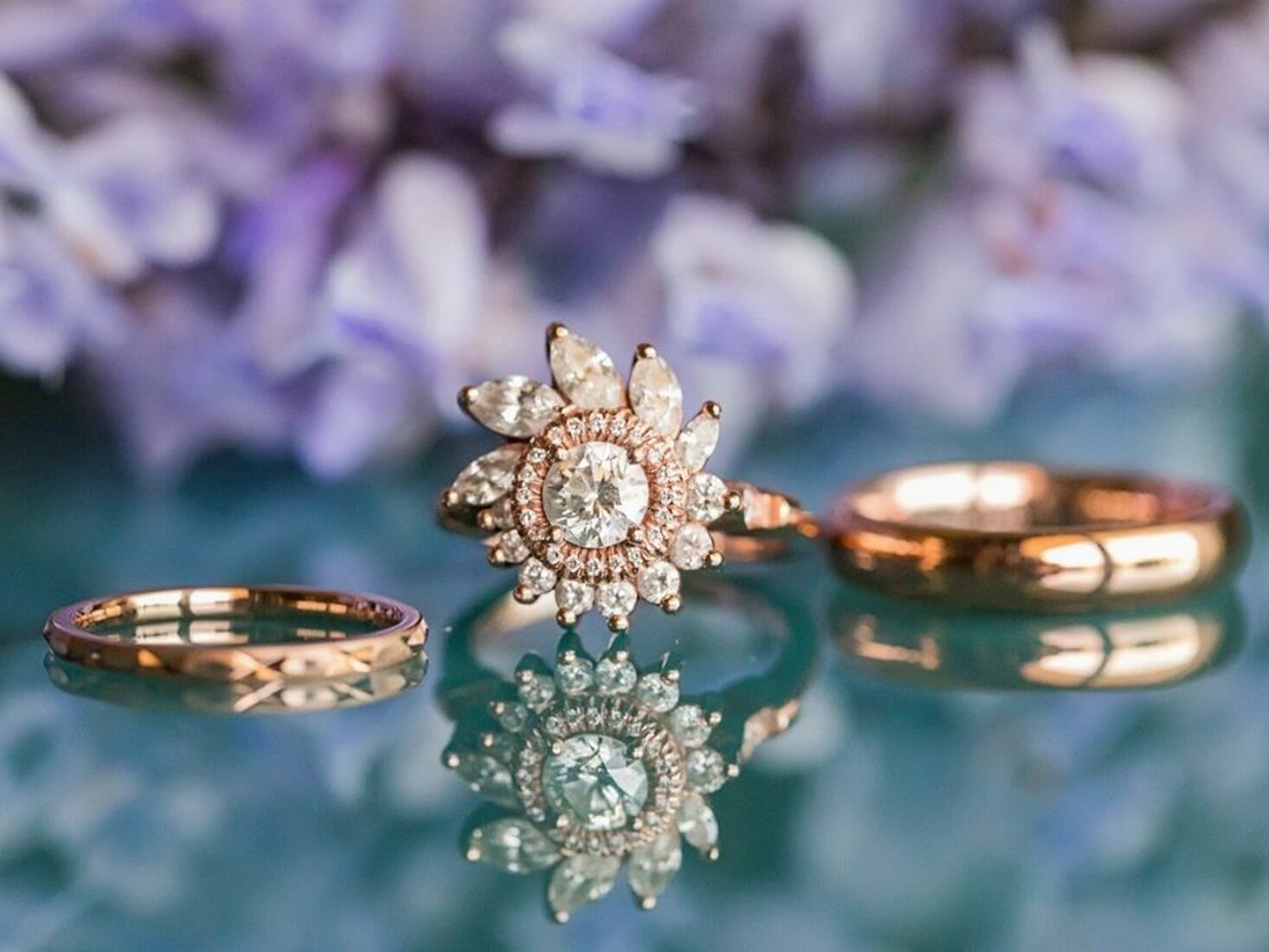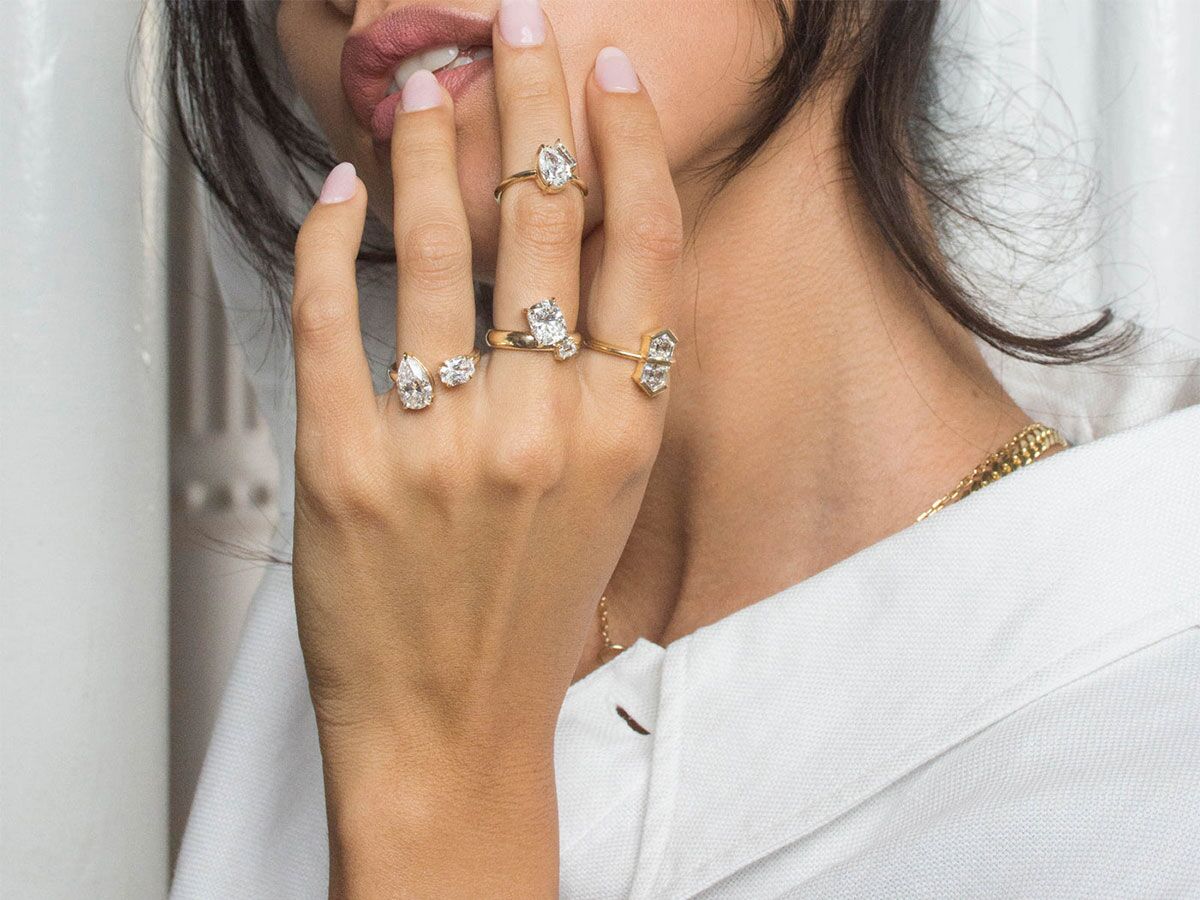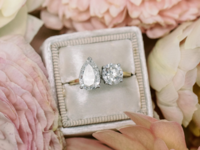Do Couples Split the Cost of An Engagement Ring? Here's What the Data Says

Engagement rings can get expensive, fast. And, if you've even casually browsed a jewelry store, you've probably started to wonder, do couples split the cost of an engagement ring? How does anyone afford a ring and, you know, an actual wedding? And what do you do if your fiancé-to-be has their eye on a five-carat stunner—and has taken an inexplicable stance against lab diamonds?
While it varies by region, the average cost of an engagement ring is $5,500. That's a lot of money for anyone. You're not just going out on a random Tuesday and dropping $5,500 at your local jeweler. Shopping for an engagement ring is something that involves time, patience, research—and maybe even your partner.
Which is why it's normal to wonder whether you both can split the engagement ring budget. Money goes further with two people, right? Isn't that the point of the double-income life? But the answer—or at least the answer that most people subscribe to—isn't quite so 50-50. Here's what the data and a financial expert have to say about whether splitting the cost of an engagement ring makes sense in 2024.
In this article:
- Do Couples Split the Cost of an Engagement Ring?
- Can Couples Split the Cost of an Engagement Ring?
- How to Discuss Splitting the Cost of an Engagement Ring
Do Couples Split the Cost of an Engagement Ring?
According to The Knot 2023 Engagement and Jewelry Study, 94% of partners who are proposing paid fully for the engagement ring. That doesn't leave much room for those who are splitting the cost of the ring. Of the remaining 6%, it was a near even split between the fiancé who was being proposed to paying for it, parents paying for it and 2% deciding to split the cost of the ring.
Can Couples Split the Cost of an Engagement Ring?
While the data doesn't look great for those who want to see more couples move towards a model where each partner contributes to the engagement ring, that doesn't mean you can't split the cost of an engagement ring. On Reddit, there are multiple threads speaking to the ins and outs of deciding to split the cost of an engagement ring. Here's what they said.
"I am considering splitting the cost of my ring with my boyfriend because he doesn't want to spend over a certain amount and I have been having one hell of a time finding a ring within budget that I love. I think it's non-traditional of us to do it but I also really want something I will love and at the end of the day, I don't really care what other people will think of my choices."
"I bought the diamond and he paid for the setting. That way I could get the bigger stone I wanted without causing him to go way over budget. I also outearn him by quite a bit, so it made total sense to me. I actually really love that I contributed to it. Makes it feel more mine to me."
"What we did was my fiancé set the budget he had allocated, we then let the jeweler know what his budget was and what I could contribute on top. Inevitably it went over his budget because we found some incredible stones that we didn't want to pass up on so I contributed about 1/3 of the overall cost."
The common theme for couples splitting the cost of an engagement ring seems to be wanting a ring that's out of the budget of one person. If you're going to hopefully wear a ring for the rest of your life, you should get what you want, right? And, if that means throwing in some money, that sits totally fine with many couples.
How to Discuss Splitting the Cost of an Engagement Ring
Whether you're the partner who's traditionally buying the ring or you're on the receiving end, bringing up the idea of splitting the cost of an engagement ring can be an uncomfortable or unexpected conversation. This is how Credit Karma's consumer financial advocate, Courtney Alev recommends approaching the topic.
Start the Conversation
Alev always recommends opening up the lines of communication first. Couples have to be comfortable discussing finances, and this could be one of the first big conversations they have. She says it's critical to understand the why of splitting the ring cost before you make a decision. "Is it because the dream ring is expensive and your partner cannot afford to pay for it on their own," Alev asks. "Is it because you prefer there to be equity in gender roles in your relationship, and you want the cost to be split evenly?" Understand the thinking beyond where you stand, then take the conversation from there.
Discuss Other Financial Obligations
Splitting a ring isn't a decision that exists in a vacuum. Alev recommends reviewing any competing financial priorities that should be considered before buying an engagement ring. You don't want to start your next chapter in debt, and your fiancé-to-be should respect where you need to stand on paying for a ring.
Alev explains, "Maybe you have high-interest debt you need to pay off or you're saving for your first home together. Ideally, you are prioritizing any needs—things like rent or medical bills—and higher-priority financial obligations over something like an engagement ring, though that decision is personal."
She notes that you can always upgrade later if you'd rather not split the ring, but also have more pressing priorities.
Set a Dollar Amount
The dollar amount you spend on a ring may shift when there are two people contributing rather than one (or it might not—and that's okay, too!). "If you plan to purchase a ring together, the first step is to set a dollar amount goal that you need to save toward based on research," Alev says.
Create a Savings Account
When you're planning a wedding, you may create a separate savings account for your wedding budget. Consider first allocating this account towards the engagement ring. Alev recommends starting to save as soon as you know an engagement is on the horizon. "Look at how many weeks or months you have to save, and carve out space in your budget to regularly contribute to your 'engagement ring fund,'" Alev says.
If you do decide to split the cost of an engagement ring, this can be the first big financial goal that you both work towards together—and there's something to be said for that relationship milestone.























